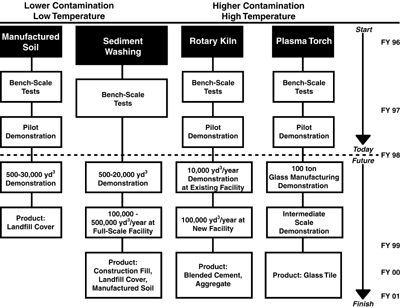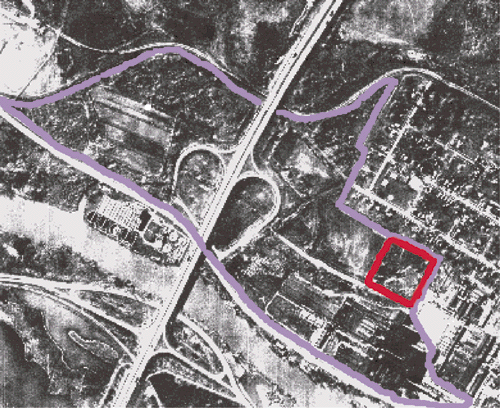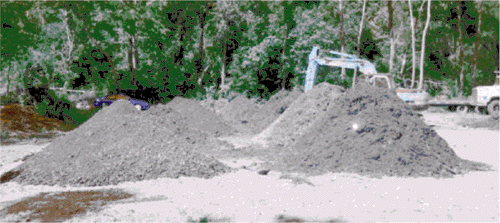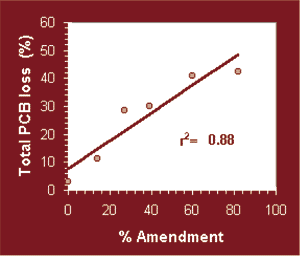
August 1998
Sediment Decontamination Program for the Port of New York and New Jersey
by Eric Stern, EPA, Region 2
Efforts to commercialize dredged-material decontamination technologies for use in the New York/New Jersey Harbor are underway by a public/private partnership involving the U.S. EPA-Region 2, the U.S. Army Corps of Engineers-New York District, the U.S. Department of Energy’s Brookhaven National Laboratory, Rensselaer Polytechnic Institute, and private industry. Through a step-wise, bench- and pilot-scale validation process, innovative and cost-effective technologies will progress to a production-scale facility capable of processing up to 500,000 cubic yards (yd3) of dredged material per year. This project is conducted under the Water Resources Development Acts of 1992 and 1996.
Major contaminants of concern in the harbor include heavy metals, chlorinated pesticides, polynuclear aromatic hydrocarbons (PAHs), polychlorinated biphenyls, and dioxins/furans. Levels of contamination vary widely, but range as high as 130,000 ppb for total PAHs; and 42, 631, and 4 ppm for arsenic, lead, and mercury, respectively.
In a sediment decontamination program such as this, the physical characteristics of the sediment are as important as contaminant concentrations because of the associated materials-handling problems and difficulty in dealing with fine-grained material. The physical characteristics of typical dredged material in the Port include fine-grained silts and clays (80-95%), a small fraction of larger grain sizes, and large-size debris. The as-dredged material is characterized as having a 30-40% solids content consisting of 3-8% total organic carbon.
A treatment train comprising materials handling, decontamination, and beneficial reuse of material is required to treat the variety of contaminants and wide range of concentrations found in dredged material in the Harbor. The project team determined that dredging/decontamination costs could be reduced significantly through the development and commercialization of a long-term, sustainable, profit-making enterprise for decontaminating sediments with a beneficial reuse. Twelve technologies initially were evaluated in bench-scale tests. Based on results of bench-scale testing, the following six completed pilot-scale testing on up to 25 yd3 of contaminated sediments:
- A thermochemical process using a gas-fired melter (rotary kiln) and modifiers. Operating temperatures ranging between 1,200° and 1,500° C achieved destruction of all organic contaminants to below detection limits, without any secondary waste streams. The end product is a pozzolanic material that can be mixed with portland cement (which immobilizes the metals) to make a marketable blended-cement product for use in the concrete and construction industries;
- A solvent-extraction process followed by solidification/stabilization using portland cement as the binding agent. Operating at temperatures of 38-60° C, this process resulted in a 90% average reduction in organic concentrations. Potential uses of the resulting soil-like material include construction fill, landfill cover, mine reclamation, and capping of brownfields and Superfund sites;
- Stand-alone solidification/stabilization using portland cement. This process serves to immobilize contaminants. Potential uses of the resulting soil-like material include construction fill, landfill cover, mine reclamation, and capping of brownfields and Superfund sites;
- A thermal vitrification process using a plasma melter. At temperatures of 1,316-1,371° C, the vitrification process resulted in a 99.9% reduction in organic and 63% reduction in metal concentrations. The end product is a glass-like material that contains the immobilized metals. This material could be used as construction aggregate or roadfill material, or could undergo further processing to make glass-fiber or glass-tile products;
- Manufactured soil production followed by phytoremediation. The U.S.
Army Corps of Engineers, Waterways Experiment Station, has developed methods
for producing manufactured soil from untreated sediment by mixing it with a
cellulose material (such as wood chips, saw dust, or yard waste compost), cow
manure, and lime and fertilizer, as needed. Commercial vendors are devising
manufactured soil technologies using decontaminated material.
Phytoremediation was used to reduce contaminant concentrations in both metals and organics. The suitability of the soil for growth of different plant species was tested for tomato, marigold, rye grass, and vinca, and it was found that the soil is most suitable for the growth of rye grass. The potential beneficial use is to serve as a topsoil layer supporting vegetative cover for landfill closure, mine reclamation, and capping of brownfields and Superfund sites;
- A sediment washing process using biodegradable surfactants, chelating agents, and oxidation. During tests, concentrations of metals and organics were reduced by approximately 90% in silts, clays, and sands. The treated material, which has the consistency and appearance of sediment, can be used to make a manufactured soil product to be used in agriculture, horticulture, forestry, parks and recreation areas, and habitat creation.
The testing program led to development of a treatment train that included both low- and high-temperature technologies capable of treating dredged material with different levels of contamination (Figure 1). Each process of the treatment train has a beneficial re-use component necessary to offset the cost of processing. Findings indicate that improved methods for removal efficiencies of inorganics are important for future technology improvements.

Figure 1. Plans for Large-Scale Decontamination
Facilities
During 1998-1999, the Port program will involve a 15,000-yd3 demonstration of an advanced sediment washing process producing manufactured soil as a beneficial re-use, and a 10,000 yd3 demonstration of a thermochemical process using a portable rotary kiln to manufacture a blended cement. Additionally, the plasma torch technology will undergo a marketability study using 1,000 pounds of vitrified dredged material. This work will lead to full-scale operation of these technologies, each capable of decontaminating at least 100,000 yd3 per year, by the year 2000.
On a parallel effort, in 1998, the New Jersey Department of the Treasury and the Office of New Jersey Maritime Resources will demonstrate new and innovative decontamination technologies capable of producing a marketable end product at a full-scale (500,000 yd3/year) cost of no more than $35/yd3. For more information, contact Eric Stern (EPA-Region 2) at 212-637-3806 or e-mail stern.eric@epa.gov.
Bioremediation of Michigan PCB-Contaminated Soils via Composting
by Frederick C. Michel, Jr., Ph.D., and C.A. Reddy, Ph.D., Department of Microbiology and NSF-Center for Microbial Ecology, Michigan State University
The Michigan Department of Environmental Quality sponsored a project at the National Science Foundation (NSF) Center for Microbial Ecology at Michigan State University (MSU) to evaluate composting strategies that could be used for the effective large-scale bioremediation of soils contaminated with polychlorinated biphenyls (PCBs) in Michigan. The site selected for the work is the former Consolidated Packaging Corporation (CPC) facility near Monroe, MI. Paper sludge covers much of this 97-acre site, and PCB (Arochlor 1242, average=4.1 Cl/biphenyl) concentrations range from 10 to 290 ppm.
The use of composting for the bioremediation of organic contaminants such as TNT, pesticides, petroleum, and other pollutants is growing rapidly in the U.S. Composting often is less costly than incineration, and may generate top-soil for site restoration. Few investigations on the effectiveness of composting in degrading recalcitrant pollutants such as PCBs, however, have been reported.
A treatment pad was constructed at the CPC site and approximately 100 yd3 of the PCB-contaminated paper sludge was excavated for use as a feedstock in composting experiments. The soil has a PCB concentration of 51± 21 ppm (Aroclor 1242), a moisture content of 65%, bulk density of 1,380 lbs/yd3, carbon content of 26%, carbon:nitrogen ratio of 50, and pH of 6.7.

Aerial view of the CPC site (outlined in red) near Monroe, MI.
The treatment area is outlined
in purple. The site is bisected by Interstate 75 and adjacent to the River
Raisin.

Compost treatment piles made with PCB contaminated soil.
The contaminated soil was mixed with an amendment composed of various levels of yard trimmings (1:1:1 leaves:grass:brush) and a shredder was used to mix the composts. The effect of amendment level on PCB degradation was determined. Environmental parameters such as temperature, oxygen content, and organic matter loss were used to monitor microbial activity involved in the PCB degradation. These experiments showed that as little as 10% amendment (by weight) led to the generation of composting temperatures greater than 50° C (an increase of 30° C from starting temperature). Little temperature change or oxygen uptake was observed in control piles containing soil alone.
PCBs exist in the environment as mixtures of congeners (single chemical compounds), with each congener containing different numbers of chlorine substituents on the biphenyl molecule. Direct organic extraction and congener-specific analysis were used to measure the relative rate and degradability of PCB congeners in the composted soil. Initial results indicated that PCB degradation can be accelerated by composting. A significant correlation between the level of amendment added to the contaminated soil and the overall PCB loss during composting was observed (Figure 2). Congener analysis indicated that less chlorinated PCB congeners (1-3 chlorines) were readily degraded, while more highly chlorinated congeners appeared to be less degradable. Overall, the extent of PCB degradation was less than that observed for pesticides (such as 2,4-D and Diazinon) and TNT in previous studies of soil bioremediation via composting.

Figure 2. Effect of Amendment Addition on the Extent of
PCB Degradation during Composting.
(r=correlation coefficient)
To improve the extent of PCB degradation, a number of strategies are being examined. Terpene compounds recently have been shown to activate microbial metabolic pathways involved in PCB biodegradation. In one set of experiments, the effect of terpene-rich amendments (pine needles and mint leaves) on PCB biodegradation is being tested. Another approach being tested at MSU is inoculation of the contaminated soil with the white-rot fungus Phanerochaete chrysosporium and other ligninolytic basidiomycetes (wood-degrading fungi), including two novel soil basidiomycetes. Laboratory studies indicate that P. chrysosporium non-specifically degrades even highly chlorinated PCBs such as Aroclor 1260. MSU scientists also are studying the relative degradability of aged versus freshly-added PCBs, and the effect of multiple composting cycles.
For further information, contact Frederick C. Michel, Jr., Ph.D., (MSU) at 517-353-8534 or e-mail michel@pilot.msu.edu, or C.A. Reddy, Ph.D., (MSU) at 517-353-8534 or e-mail reddy@pilot.msu.edu.
International Cleanup Pilot Studies
Proceedings of a North Atlantic Treaty Organization Committee on the Challenges of Modern Society (NATO/CCMS) conference held February 22-23, 1998, are now available. NATO/CCMS Pilot Study on Evaluation of Demonstrated and Emerging Technologies for the Treatment of Contaminated Land and Groundwater (Phase III) 1998 Annual Report (EPA 542-R-98-002) contains national status reports from 18 countries on hazardous waste remediation, abstracts of 15 demonstration pilots accepted for Phase III, and contacts for participating countries. Also available is a companion document entitled Treatment Walls and Permeable Reactive Barriers, which summarizes a special session held during the February conference on the construction of permeable reactive barriers, reactive media, and related case studies (EPA 542-R-98-003).
During the NATO/CCMS conference, four case studies nominated by the U.S. were accepted for the Phase III pilot study:
- Treatability of enhanced in situ anaerobic dechlorination sponsored by the U.S. Air Force at five locations across the country;
- Permeable reactive barriers for in situ treatment of chlorinated solvents constructed by the U.S. Air Force at Dover Air Force Base, DE;
- Dynamic underground stripping by the U.S. Department of Energy at a pole yard in Visalia, CA [for more information, see the June 1998 issue of Ground Water Currents]; and
- Phytoremediation of chlorinated solvents conducted jointly by the EPA and the U.S. Air Force at three Superfund sites.
A final report on Phase II of the NATO/CCMS pilot studies providing a short description of each of the more than 50 projects involved in the NATO/CCMS study, characterization of the projects, and related recommendations was issued in two volumes in June 1998 (EPA 542-R-98-001). The Phase III proceedings, special session, and Phase II reports may be viewed or downloaded from the World Wide Web at clu-in.org/intup.htm, or obtained from EPA’s National Center for Environmental Publications and Information at 513-489-8190.
Permeable Reactive Barrier Installation Profiles Now Available
Profiles on permeable reactive barriers (PRBs) were recently compiled to develop a comprehensive reference source on completed and ongoing pilot- and full-scale PRB demonstrations, as well as full-scale PRB installations. The Permeable Reactive Barriers Action Team of the interagency Remediation Technologies Development Forum (RTDF) sponsored development of the initial profiles, which are located on the World Wide Web at www.rtdf.org/barriers.htm, and will be updating and adding new profiles as information becomes available. Intended to provide potential users of PRB technology with information for making more informed decisions, the profiles contain data such as site name, location, and characteristics; PRB reactive media, construction types, and costs; and points of contacts for further information.
| We now offer a new service-TechDirect-to keep you abreast of new EPA publications and event of interest to site remediation and site characterization professionals. Once a month, a TechDirect message will be sent via email describing new products and instructions on how to obtain them. |







